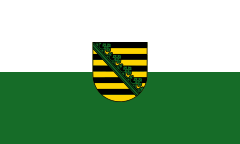This is an old revision of this page, as edited by Lysy (talk | contribs) at 15:31, 15 October 2006 (→Geography: rm empty subsection). The present address (URL) is a permanent link to this revision, which may differ significantly from the current revision.
Revision as of 15:31, 15 October 2006 by Lysy (talk | contribs) (→Geography: rm empty subsection)(diff) ← Previous revision | Latest revision (diff) | Newer revision → (diff) This article is about the modern federal state of Saxony in eastern Germany. For other states and places with the same name, see Saxony (disambiguation).| Free State of Saxony Freistaat Sachsen Swobodny Stat Sakska | |
|---|---|
| State Service Flag | |
 | |
| Civil Flag | |
 | |
| Statistics | |
| Capital: | Dresden |
| Area: | 18,413 km² |
| Population: | 4,300,000 (2004) |
| pop. density: | 234 inh./km² |
| Website: | sachsen.de |
| ISO 3166-2: | DE-SN |
| Politics | |
| Minister-president: | Georg Milbradt (CDU) |
| Ruling party: | CDU/SPD |
| Map | |
 | |
The Free State of Saxony (German: Freistaat Sachsen; Sorbian: Swobodny Stat Sakska) is a federal state of Germany. It has a land area of 18,413 km² and a population of 4.3 million, the tenth-largest in area and sixth-largest in population among Germany's sixteen states.
Saxony has a long history as a duchy, and eventually kingdom. Monarchy was overthrown and it became a republic under its current name in 1918. Abolished during communist rule, it was reestablished in 1990.
The capital city of Saxony is Dresden. Other major cities include Leipzig and Chemnitz.
During the early Middle Ages the term Saxony referred to the region occupied by today's states of Lower Saxony and northern North Rhine-Westphalia. The Saxons had migrated there from the area of present-day Schleswig-Holstein between 250 and 500. See the history section below.
Saxony cannot necessarily be directly related to every other meaning of "Saxons"; that is, a Saxon is not necessarily an inhabitant of Saxony (e.g. Saxon people, Anglo-Saxons or Saxons of Romania). For full disambiguation of the meaning, see Saxon (disambiguation).
Geography
Borders and cities
Saxony borders, from the east and clockwise, on Poland, the Czech Republic and the German states of Bavaria, Thuringia, Saxony-Anhalt and Brandenburg. Its capital is Dresden, and the other principal cities are Leipzig and Chemnitz.
Landscape and climate
The main axis of Saxony is the Elbe river, crossing the state from southeast to northwest. Another important river, west of the Elbe, is the Mulde. The Neiße river forms the Polish border. The portions in the east of Saxony are the southern parts of the historical region of Lusatia (Lausitz) and are called Upper Lusatia (Oberlausitz); the minority of the Sorbs live in the region, which is bilingual today.
The countryside rises gradually from north to south, culminating in the mountain ranges along the Czech border. The Ore Mountains (Erzgebirge) extend from Bavaria to the Elbe river. The Elbe itself has cut a majestic gorge to pass the mountains of the Elbsandsteingebirge, better known as Saxon Switzerland. Further east the mountains are less high and form a hilly countryside called the Lausitzer Bergland. See also List of places in Saxony.

Economy
Saxony has been observed to have the most vibrant economy among the former GDR states. Its economy grew by 2.1% in 2004, making it the only eastern state to exceed the national average. Nonetheless, unemployment remains high and investment is scarce. Because of these factors, Saxony, along with the rest of the east (excluding Berlin) qualifies as an "Objective 1" development region within the European Union, and thus can receive investment subsidies of up to 30% until 2013. In the interests of encouraging growth, the state government has attempted to develop tourism in the region, notably in the lake district of Lausitz (Economist, Aug. 27, 2005).
History
Main article: History of SaxonyPrehistoric Saxony was the site of some of the largest of the ancient Central European monumental temples, dating from the 5th millennium BC. Notable archeological sites have been discovered in Dresden and the village of Aythra near Leipzig.
For the origins of the Saxon tribes see Saxons.
Foundation of the first Saxon state

The first Duchy of Saxony emerged about AD 700 in today's Lower Saxony and North Rhine-Westphalia. In the 10th century the dukes of Saxony were at the same time kings (or emperors) of the Holy Roman Empire (Ottonian or Saxon Dynasty). At that time, a Saxon noble family of Billungs received extensive fiefs in Saxony, and the Emperor eventually gave them the title of Duke of Saxony. After the extinction of the male line of Billungs, the duchy was given to Lothar of Supplinburg, who then also became Emperor for a short time.
In 1137 Saxony was passed to the Welfen dynasty, who were descendants (1) of Wulfhild Billung, eldest daughter of the last Billung duke, and (2) of the daughter of Lothar of Supplinburg. It reached its peak under Duke Henry the Lion, and after his death it began to decline (Henry had declined to participate in the later Italian wars of his liege lord, Emperor Frederick Barbarossa, and those expeditions to Italy ended in disasters. The furious emperor retaliated and sent his troops to end Duke Henry's dominion). In 1180 large portions west of the Weser were ceded to the Bishops of Cologne, while some central parts between Weser and Elbe remained to the Welfs, later forming the Duchy of Brunswick-Lüneburg). The remaining Eastern lands, together with the title of Duke of Saxony, were passed to an Ascanian dynasty (who descended from Eilika Billung, Wulfhild's younger sister) and divided in 1260 into the two small states of Saxony-Lauenburg and Saxony-Wittenberg. Saxony-Lauenburg was later renamed Lauenburg and was no longer part of Saxony or its history. Saxe-Wittenberg was confirmed to have inherited the "main" ducal title of the Saxons and as such was recognized as an Elector of the Empire in 14th century.
Foundation of the second Saxon state


Saxony-Wittenberg, in present Saxony-Anhalt, became subject to the margravate of Meißen and ruled by the Wettin dynasty in 1423. A new powerful state was established, occupying large portions of present Saxony, Thuringia and Saxony-Anhalt. Although the center of this state was far southeast of the former Saxony, it came to be referred to as Upper Saxony and then simply Saxony, while the former Saxon territories were now known as Lower Saxony.
In 1485, Saxony was split as a collateral line of the Wettin princes received what later became Thuringia and founded several small states there (see Ernestine duchies). The remaining Saxon state became even more powerful, becoming known in the 18th century for its cultural achievements, although it was politically inferior to Prussia and Austria, which pressed Saxony from either side.
Saxony in the 19th and 20th centuries
With the abolition of the Holy Roman Empire in 1806, the Electorate of Saxony became a kingdom, and Elector Frederick Augustus III became King Frederick Augustus I. Frederick Augustus made the mistake of remaining loyal for too long to Napoleon I, and he was taken prisoner and his territories declared forfeit by the allies in 1813, with the intention of their being annexed by Prussia. Ultimately, the opposition of Austria, France, and the United Kingdom resulted in Frederick Augustus being restored to his throne at the Congress of Vienna, but Saxony was forced to cede the northern part of the kingdom to Prussia. These lands became the Prussian province of Saxony, which is today incorporated in Saxony-Anhalt. What was left of the Kingdom of Saxony was roughly identical with the present federal state.
During the 1848-49 constitutionalist revolutions in Germany, Saxony became a hotbed for revolutionaries, with anarchists such as Mikhail Bakunin and democrats including Richard Wagner and Gottfried Semper taking part in the May Uprising in Dresden in 1849.
After 1918 Saxony was a state in the Weimar Republic and was the scene of Gustav Stresemann's overthrow of the KPD/SPD led government in 1923, during the Nazi era and under Soviet occupation. It was dissolved in 1952, and divided into three smaller 'Bezirke' based on Leipzig, Dresden and Karl-Marx-Stadt, but reestablished within slightly altered borders in 1990 upon German reunification. Saxony also includes a small part of previous Silesia west of the town of Görlitz which remained German after the war and which for obvious reasons of unviability as a separate state was incorporated into Saxony. This part has been part of Silesia only after 1815 and belonged as part of Upper Lusatia to Bohemia before 1623 and previously to Saxony between 1623 and 1815.
Culture
Language

The most important patoises that are spooken in Saxony are combined in the group of "Thuringian and Upper Saxon dialects". Due to the incorrect name of "Saxon dialects" in colloquial language the Upper Saxon attribute has been added to distinguish from Old Saxon and Low Saxon. Other German dialects spoken in Saxony are the dialects in the Ore Mountains which has been affected by Upper Saxon dialects and the dialects of the Vogtland which is more affected by the east frankish languages.
Sorbian (a Slavic language) is still activily spooken in the parts of Upper Lusatia that are occupied by the Sorbian minority.
Tourism
Tourism is not well developed in Saxony. The potentially more attractive regions are the ones shared with Czech Republic, including Lusatian Mountains, Ore Mountains, Saxon Switzerland, and Vogtland.
Politics
List of Minister-presidents of Saxony
For earlier rulers, see Rulers of Saxony.
- 1918 - 1919: Richard Lipinski (USPD)
- 1919 - 1920: Georg Gradnauer (SPD)
- 1920 - 1923: Wilhelm Buck (SPD)
- 1923: Erich Zeigner (SPD)
- 1923 - 1924: Alfred Fellisch (SPD)
- 1924 - 1929: Max Heldt (SPD)
- 1929 - 1930: Wilhelm Bünger (DVP)
- 1930 - 1933: Walter Schieck (no party)
- 1933 - 1935: Manfred Freiherr von Killinger (NSDAP)
- 1935 - 1945: Martin Mutschmann (NSDAP)
- 1945 - 1947: Rudolf Friedrichs (SPD, then SED)
- 1947 - 1952: Max Seydewitz (SED)
- 1990 - 2002: Kurt Biedenkopf (CDU)
- since 2002: Georg Milbradt (CDU)
September 19, 2004 state election
See also: Saxony state election, 2004
Georg Milbradt (CDU), losing his absolute majority, had to form a grand coalition with the SPD to remain in office as Minister-president.
| Party | Party List votes | Vote percentage | Total Seats | Seat percentage |
|---|---|---|---|---|
| Christian Democratic Union (CDU) | 855,203 | 41.1% | 55 | 44.4% |
| Party of Democratic Socialism (PDS) | 490,488 | 23.6% | 31 | 25.0% |
| Social Democratic Party (SPD) | 204,438 | 9.8% | 13 | 10.5% |
| Alliance '90/The Greens | 106,771 | 5.1% | 6 | 4.8% |
| National Democratic Party (NPD) | 190,909 | 9.2% | 12 | 9.7% |
| Free Democratic Party (FDP) | 122,605 | 5.9% | 7 | 5.6% |
| Mensch Umwelt Tierschutz (Humans, the Environment, and Animal Rights) | 34,068 | 1.6% | 0 | 0.0% |
| All Others | 75,653 | 3.7% | 0 | 0.0% |
| Totals | 2,080,135 | 100.0% | 124 | 100.0% |
Notably, the far-right NPD received two more votes in the ballot for Minister-president than it had members. It is presumed that two CDU Landtag members must have backed the NPD leadership.
References
- "Still Troubled". The Economist, August 27-September 2, 2005.
External links
| States of the Federal Republic of Germany | ||
|---|---|---|
| States |
|  |
| City-states | ||
| Former states |
| |